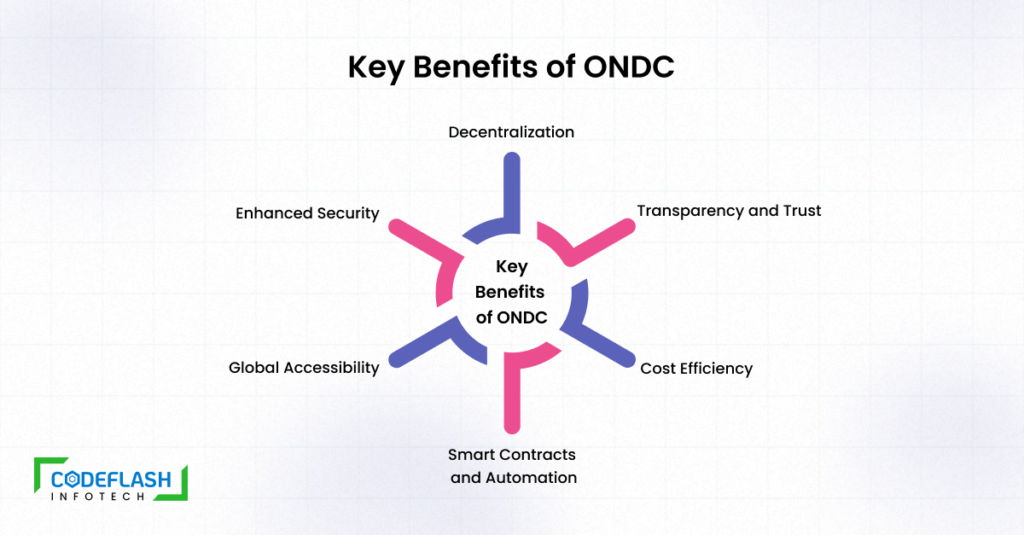
ONDC: India's Open Network for Digital Commerce
Written by: Parth Hirapara | 01 DECEMBER
Do you want to know how the Indian Government makes e-commerce more accessible and inclusive through open networks? If yes, you should learn about Open Network for Digital Commerce (ONDC), a set of specifications based on the open-sourced methodology that enables consumers and suppliers to transact goods and services independently of any platform or application.
This blog will explain what Open Network for Digital Commerce ONDC is, how it works, and its features and objectives. We will also discuss some key benefits and challenges of using this network.
What is ONDC?
ONDC stands for Open Network for Digital Commerce, an initiative of the Department for Promotion of Industry and Internal Trade of the Government of India. It is a non-profit private Section 8 company that provides a set of specifications and network protocols that ensure it is independent of any platform. It is designed to nurture open interchange and connections between consumers, technology platforms, and retailers.
ONDC aims to break the current platform-centric e-commerce model and provide an open network that any innovative buying platform can access. It allows consumers and suppliers to compare prices, quality, discounts, and delivery options across different platforms and apps. It also enables them to choose delivery agents from other apps if the selected app’s delivery agent is unavailable to provide delivery services.
How does ONDC work?
ONDC’s working can be better understood if we compare it to UPI, the Unified Payment Interface. UPI allows anyone with a bank account to use mobile payments irrespective of whether they use a particular app. Similarly, ONDC is the intermediary layer between the interfaces hosting the buyers and the sellers.
For example, if a buyer wants to buy a phone online, they will search on any existing eCommerce apps available, like Amazon or Flipkart. The buyer would have to surf individual apps to find the best deals. This can be time-consuming. ONDC provides a solution for this problem.
Suppose the buyer uses Open Network for Digital Commerce (ONDC) to open any existing e-commerce apps like Amazon. In that case, they will get a listing of sellers within the Amazon app and options from Flipkart, other stores, and any other app registered with ONDC. ONDC thus ensures buyers with opportunities to compare prices, quality, discounts, etc., across different platforms and apps.

Features and Objectives of ONDC
Some salient features of Open Network for Digital Commerce are:
- It is a government-backed project that aims to provide equal opportunities to all players in the market.
- It enables access to processes and technologies used by large eCommerce platforms, such as listing, stock management, order management, and order fulfillment.
- It provides better discoverability and trust for small and medium enterprises. Simplified payment processing is also available.
- It offers data transparency. ONDC can rate service providers applicable and visible across the network.
- It provides digital marketing opportunities and easy-to-use tools to create a branded storefront. Small businesses are also entitled to discount programs.
- It offers access to products that may not be available on eCommerce sites but are readily available locally.
- It provides a unique opportunity for small traders and mom-and-pop stores.
The objectives of Open Network for Digital Commerce are:
- Ending monopolies of the platforms: It strives to provide a conducive environment for small businesses to compete with established players.
- Enabling digital commerce to be small business friendly: It provides easy-to-use tools and resources for small retailers to grow and expand their businesses online.
- Increasing eCommerce penetration in rural areas: It provides access to new markets and opportunities for small businesses in rural areas.
- More focus on apps in Indian languages: It provides a platform for small retailers to reach a wider audience with their products and services.
- Digitization of the value chain: It aims to streamline processes and make them more efficient and cost-effective.
- Standardization of operations: It provides a standard set of protocols and guidelines for small retailers.
- Increased efficiency in logistics: It provides a platform for small retailers to connect with logistics providers and streamline their supply chain.
- Wider choices of products and services: It provides access to a diverse range of products and services for small retailers to offer their customers.
- Data privacy and confidentiality: It aims to ensure that all data and information shared on the platform are secure and protected.
- Decreased cost of operation: ONDC aims to provide cost-effective solutions for small retailers to grow and expand their businesses online.

Key Benefits of Open Network for Digital Commerce (ONDC)
Some key benefits of using ONDC are:
- Decentralization: The Open Network for Digital Commerce operates on a decentralized model, ensuring that no single entity has complete control over the network. This democratized approach empowers participants, promotes fair competition, and prevents monopolistic practices.
- Transparency and Trust: The Open Network for Digital Commerce establishes trust between buyers and sellers by leveraging blockchain technology. All transaction records are securely stored on the blockchain, allowing participants to verify and validate the authenticity of transactions.
- Cost Efficiency: The Open Network for Digital Commerce reduces transaction costs by eliminating intermediaries and facilitating direct peer-to-peer transactions. This can significantly benefit businesses and consumers, lowering transaction fees and increasing affordability.
- Enhanced Security: The decentralized nature of the Open Network for Digital Commerce makes it highly secure. Blockchain technology ensures that transactions are resistant to tampering and fraud. Additionally, using cryptographic techniques provides robust protection for sensitive data, safeguarding it from unauthorized access.
- Global Accessibility: The Open Network for Digital Commerce has the potential to break down barriers and promote financial inclusion. Its decentralized nature allows anyone with internet access to participate, regardless of geographical location or traditional banking infrastructure. This opens up new opportunities for individuals and businesses in underserved regions to engage in digital commerce.
- Smart Contracts and Automation: The Open Network for Digital Commerce can leverage smart contracts, self-executing contracts with the terms of the agreement directly written into code. This automation streamlines processes eliminates manual interventions, and ensures efficient execution of transactions. It also reduces the risk of disputes and enhances overall transaction efficiency.
Challenges of Open Network for Digital Commerce (ONDC)
Some challenges of using ONDC are:
- Scalability: The Open Network for Digital Commerce must handle many transactions and data across different platforms and apps. This will require a scalable and robust infrastructure supporting the network’s growth and performance.
- Regulatory Compliance: The Open Network for Digital Commerce must comply with various laws and regulations related to digital commerce, such as taxation, consumer protection, data privacy, etc. This will require a clear and consistent legal framework that can address the complexities and uncertainties of the network.
- User Experience: The Open Network for Digital Commerce must provide a user-friendly and intuitive interface that can attract and retain users. This will require a design that can balance simplicity and functionality and cater to users’ diverse needs and preferences.
Conclusion
The Open Network for Digital Commerce is an innovative concept that can revolutionize digital commerce, offering a secure, transparent, and cost-effective alternative to traditional centralized systems. This open and decentralized network can foster trust, enable financial inclusion, and unlock new opportunities for businesses and individuals worldwide by leveraging blockchain technology. However, addressing scalability, regulatory compliance, and user experience will be crucial in realizing the full potential of this revolutionary concept.




